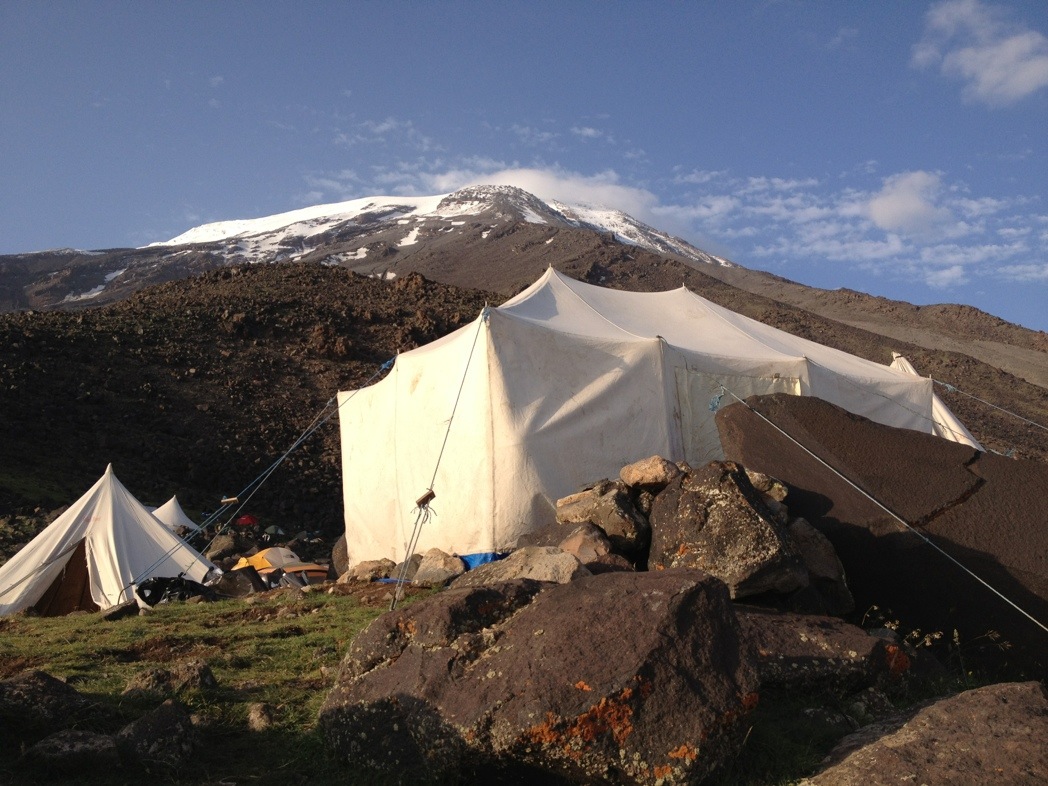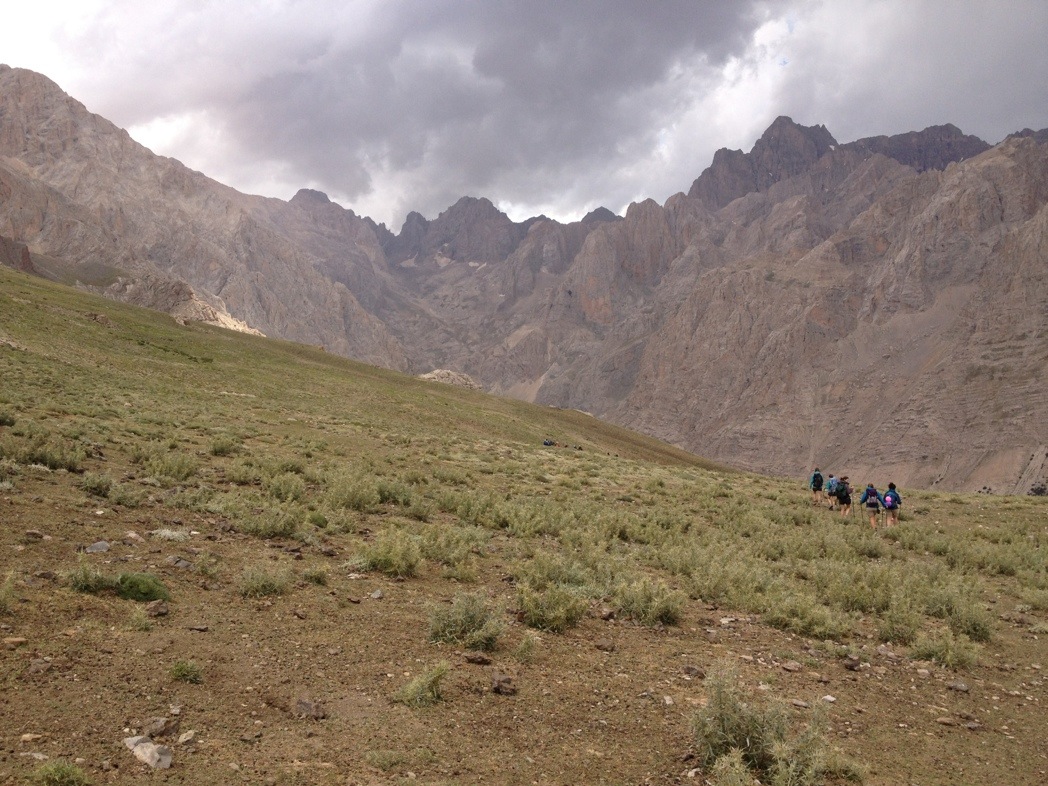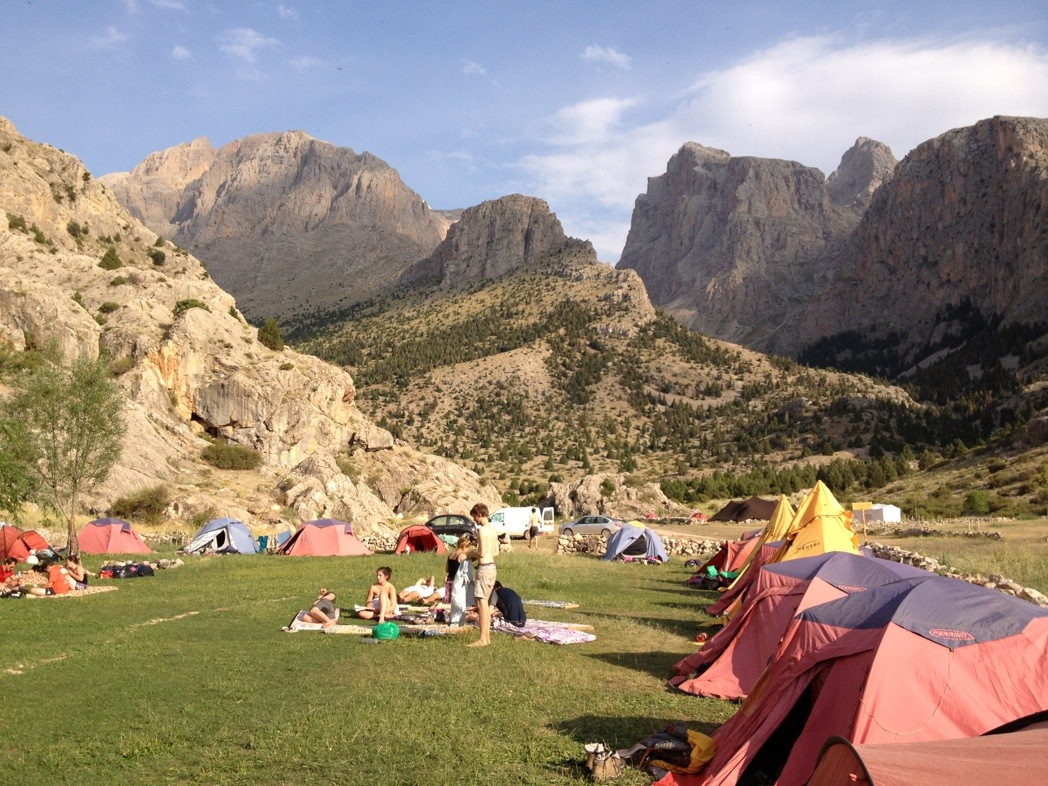With the rain that has fallen on Ararat over the last few days you might have thought that the Ark would float once more, or at least be swept down the mountain in a torrent of water. On Monday, the day before our ascent of the mountain began, there was a huge storm with torrential rain. The water rushed down the mountain gathering force and momentum so that by the time it reached the bottom of the mountain it was a force to be reckoned with. Eli village took the full brunt of the surge. Fortunately the water took the easiest route, the road, and spared the houses. The road, however was completely destroyed. Our vehicles could no longer go to the normal start point for the climb 150m above the village but only to the village itself and that was not without difficulty.
Disembarking from our vehicles after the bumpy ride, we prepared ourselves for the 1300m ascent up to base camp. It is a relatively gentle slog, first up the dirt road and then a good path up to the camp. Parts of the dirt road proved more difficult than normal because of the boulders strewn across it and in one place a gash six to eight feet deep along the road and almost the full width of it.
I stayed at the back picking up stragglers who were struggling for a number of reasons. We seemed to always have one or two suffering with stomach problems after a couple of days in towns. It was not an unpleasant walk although looking up to the summit was daunting for some. It towers above you, getting steeper all the time. The snow line was considerably lower than my previous climb in 2010 and this added to the anxiety. Everybody realised that this was not going to be like anything they had done before; this was going to be serious.
The lower slopes of Ararat were much greener this year and there were several nomad camps dotted about. As we passed them hoards of children came to meet us trying to sell us scarves which they had made, and requesting, not always pleasantly, for sweets, pens or money. The girls tended to be quite reserved but the boys were much more aggressive and rude. With one group I had to give them a warning glare before they would back off.
After four hours or so we reached camp, a crowded selection of tents pitched anywhere where there was a flat place or where one could be created. These tents tend to stay in situe throughout the climbing season and were beginning to show signs of wear and tear.

Our second day on the mountain was an acclimatisation day with a walk up to 4000m and back to base camp. There were a number who were not very well so we gave them a rest day. They had already been up to 3700m in the Taurus Mountains; a rest would be far more beneficial. Our main concern was with one student who had been ill before leaving the UK and still had a lingering cough, a temperature and all the symptoms of a chest infection. Whilst we hoped to at least get him to high camp we realistically did not expect him to summit.
Leaving five of the group behind the rest of us set out to climb up to 4000m. Ildrum, our mountain guide set an excellent pace that allowed everybody to stay together. The pace was broken when Aliza felt dizzy and sick. I opted to take her back to camp. She would gain nothing by going higher and it was important that she was fit for summit day as it was her seventeenth birthday, one she will never forget if she is successful. The rest of the group were back in camp by lunch time and enjoyed their picnics in warm sunshine.
Things changed very rapidly. We soon found ourselves enveloped in cloud rising from below and the temperature dropped dramatically. The rain soon followed, gently to begin with and then torrentially with large hail stones. The thunder was constant and boomed just above our heads as it moved horizontally across the mountain. This really tested the tents and a number were found to let water in, mine included, which had puddles forming on the groundsheet. I have no idea where it was coming in but I noticed it in time to make sure that essentials such as sleeping bag remained dry.
The storm rumbled on for a couple of hours and then disappeared into the distance. The rain came and went several more times into the night but nothing as heavy as the first downpour. What effect would this have on the lower slopes?
Most of those who had been ill were improving and we had hopes for everybody except the one with the chest infection. I decided that I would go no higher than high camp but look after any who went no further or who returned early from the summit attempt. It was logical as I was the only member of the team to have been to the summit before and I did not want to deny anybody else the opportunity.
In the morning Jenny still had serious concerns about the chest infection and felt it unwise for him to go higher. Although I had prepared him for the news, it is never easy to hear but he took it well. I gave him the choice of staying put in base camp or going back down to Dogubayazit. He chose the latter so while the rest of the group prepared to go up to high camp and beyond, I and my patient prepared to descend. It was a motley crew we went down with, a Turkish woman from Istanbul, a Turkish man married to a Kazak Russian who cried all the way down because she felt she could have made it to the summit. She could hardly make it down from base camp, let alone climb up. There were also three Bulgarians, one a chain smoker, an overweight man constantly on his mobile and his wife. It took us over four hours to reach Eli and a lift back to the hotel. My patient seemed relieved to be off the mountain and can begin to get himself better without his body having to suffer the extremes of Mt. Ararat.
Meanwhile the rest of the group reached high camp safely and set off for the summit at 3.00am on Friday 3rd August. The cloud was down, it was windy and it was very cold. Only one student felt it necessary to turn back at 4760m suffering from altitude sickness and Omer took him back to high camp. The rest of the group went on to summit at 7.30am but sadly did not have any views. It remained very cold and after only ten minutes on the summit they started the long descent to base camp, all except Jenny, Paul and Omer who came all the way back to Dogubuyazit, Jenny and Paul because they have to be at work on Monday and Omer because he has to begin guiding another group arriving late on the 4th. It is a shame they cannot be with us to the very end and I am extremely grateful to them for making this an exceptional trip.
Twenty one students left Worcester on 14th July and eighteen reached the summit of Mt. Ararat (5137m) on the 3rd August. In addition six of the seven staff also reached the summit. Not a bad result.



